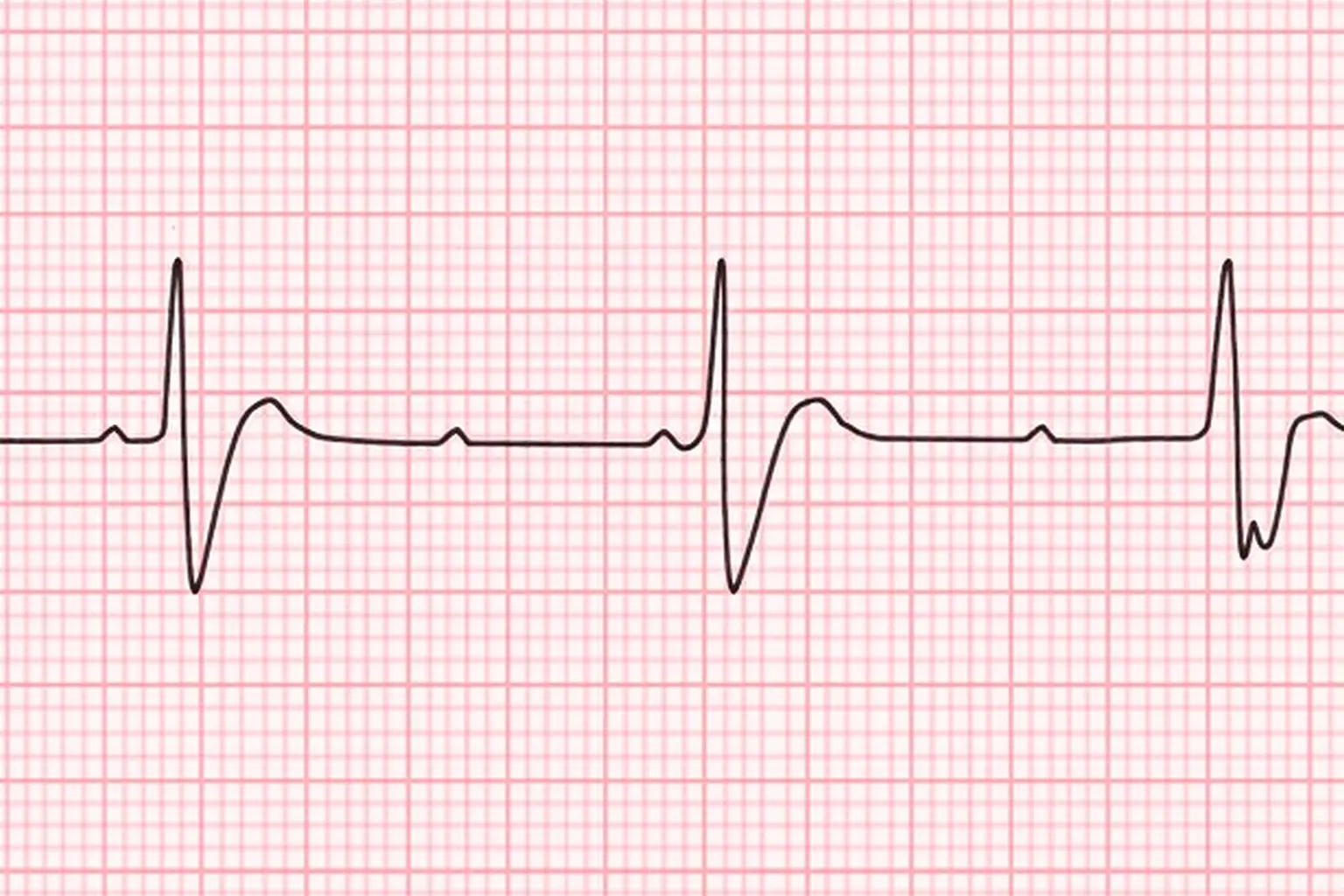Symptomatic Bradycardia-Slow Heart Rate
Rules for Sinus
Bradycardia

Figure 30
| Regularity | R-R intervals are regular, overall rhythm is regular. |
| Rate | The rate is less than 60 bpm, but usually more than 40 bpm. |
| P Wave | There is one P wave in front of every QRS. The P waves appear uniform. |
| PR Interval | Measures between 0.12 and 0.20 seconds in duration. PR interval is consistent. |
| QRS Complex | Measures less than 0.12 seconds. |
Table 11
Rules for First Degree Heart Block

Figure 31
| Regularity | R-R intervals are regular, overall rhythm is regular. |
| Rate | The rate depends on the underlying rhythm. |
| P Wave | There is one P wave in front of every QRS. The P waves appear uniform. |
| PR Interval | Measures more than 0.20 seconds in duration. PRI is consistent. |
| QRS Complex | Measures less than 0.12 seconds. |
Table 12
Rules for 2nd Degree Type I AV Block (Wenckebach/Mobitz I)

Figure 32
| Regularity | R-R interval is irregular, but there is usually a pattern to it. The R-R interval gets longer as the PR interval gets longer. |
| Rate | The ventricular rate is usually slightly lower than the atrial rate due to some atrial beats not being conducted. The atrial rate is usually normal. |
| P Wave | P waves are upright and uniform. Most complexes will have a P wave in front of them; however, there will be some P waves that do not have a QRS complex. |
| PR Interval | PR interval gets progressively longer until there is a dropped QRS complex. |
| QRS Complex | Measures less than 0.12 seconds. |
Table 13
Rules for 2nd Degree Type II AV Block
(Mobitz II)

Figure 33
| Regularity | If there is a consistent conduction ratio, then the R-R interval will be regular. If the conduction ratio is not constant, the R-R interval will be irregular. |
| Rate | The atrial rate is normal. The ventricular rate is slower, usually 1/2 to 1/3 slower than the atrial rate. |
| P Wave | P waves are upright and uniform. There is not a QRS following every P wave. |
| PR Interval | PR interval can only be measured on conducted beats, and it is usually constant across the strip. It may or may not be longer than a normal PR interval (0.12 seconds) |
| QRS Complex | Measures less than 0.12 seconds. |
Table 14
RULES FOR 3RD
DEGREE AV BLOCK
(COMPLETE HEART BLOCK)

Figure 34
| Regularity | R-R interval is regular. P-P interval is also regular. |
| Rate | The atrial rate is regular and normally 60 to 100. Rate of QRS complexes is dependent on the focus. If the focus is ventricular, the rate will be 20 to 40. If the focus is junctional, the rate will be 40 to 60. |
| P Wave | P waves are upright and uniform. There is not a QRS following every P wave. |
| PR Interval | PR interval can only be measured on conducted beats, and it is usually constant across the strip. It may or may not be longer than a normal PR interval (0.12 seconds). |
| QRS Complex | Interval may be normal but is more likely to be prolonged. |
Table 15
Symptomatic Bradycardia
Bradycardia is the condition where the heart beats at a rate less than 60 beats per minute. Though any heart rate pumping out less than 60 beats in a minute may be considered bradycardia, this isn’t always a point for concern. Even people who are physically fit can experience sinus bradycardia. Bradycardia is often indicative of low blood pressure, pulmonary edema and congestion, abnormal rhythm, discomfort in the chest, shortness of breath, lightheadedness, and/or confusion. On the other hand, symptomatic bradycardia should be attended to with the ACLS Survey. If this condition is asymptomatic but still happens within the arrhythmia illustrated in the following sections, rhythm disorders can easily be remedied by consulting with a cardiologist.
Symptoms of Bradycardia
- Uneven breathing
- Altered mental status
- Pulmonary edema/congestion
- Hypotension
- Weakness/dizziness/lightheadedness
Symptomatic Bradycardia Review
Sinus Bradycardia
- Slow rate with normal rhythm
First Degree AV Block
- PR interval is longer than 0.20 seconds
Type I Second Degree AV Block
- Interval of the PR increases in length until QRS complex is dropped
Type II Second Degree AV Block
- Constant PR intervals (may be prolonged) before a random QRS is dropped
Third Degree AV Block
- P waves and QRS complex are not coordinated with each other
